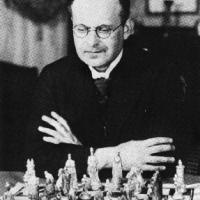
Nimzowitsch (in 4 syllables)
The Nimzowitsch Defense, 1. e4 Nc6, is named after the über-famous Aron Nimzowitsch (1886—1935), whose last name at birth was the 4-syllable ‘Niemzowitsch’. The opening, as others we have looked at in this series, was not invented by its namesake. Rather, Nimzowitsch popularized the opening, which had been around since the 16th century. Another opening that bears his name is 1. Nf3, which is then followed by 2. b3, the Nimzowitsch Opening.
Most people would be fortunate to have just one opening bearing their name, but Nimzowitsch had at least three, and even more if we count variations of other openings. The most well-known opening named after the 3rd strongest player in the world between 1925 and 1930 is the Nimzo-Indian: 1. d4 Nf6 2. c4 e6 3. Nc3 Bb4
To say that Aron Nimzowitsch was an openings specialist would be to dramatically understate his significance to the game. I am often struck how one seemingly small incident sometimes makes a profound impact upon a person, compelling him or her to accomplish great things. For example, John Steinbeck was inspired to become a writer because his uncle gave him Malory's book on the Arthurian legends.
In 1904, Tarrasch was critical of how Nimzowitsch played. This rebuke stung him, and he began to study the traditional concepts of center control by Tarrasch himself. This led to an examination of many ‘unorthodox’ openings by masters such as Steinitz, Chigorin and others. Nimzowitsch perfected his own ideas that were seeded by these predecessors, and the result was the Hypermodern Movement and a significant strengthening of the concept of positional play.
His initial study paid off, and three years after Tarrasch’s criticism, Nimzowitsch tied for third behind Bernstein and Rubinstein at the Ostend Masters Tournament.
Nimzowitsch left Latvia shortly after the first World War and adopted the misspelling of his last name on his new passport, taking up residence in Copenhagen in 1922 as Aron Nimzowitsch.
Throughout the 1920’s, Nimzowitsch perfected his ideas, culminating in the publication in German of three books: Die Blockade in 1925, and Mein System and Die Praxis meines Systems in 1929. These have been translated into English as The Blockade, My System, and Chess Praxis.
If you have not yet read My System, do so immediately. A marvelous and enlightening read, it is available in a new edition from Hays Publishing that uses algebraic notation. One can see the influence of scientific and mathematical thought on Nimzowitsch in the structure and exposition of this book. The first part's title, ‘The Elements’, reminds us of Euclid and begins with a careful enumeration of elementary concepts and definitions and proceeds to more advanced notions that build upon these chess ‘axioms’. Part Two presents his thinking on positional play, and the book ends with 50 illustrative games.
It is in this work that we find Nimzowitsch’s famous maxim that a passed center pawn “must be regarded as a dangerous criminal. Against him all our chess fury must be directed.”
This was Nimzowitsch at the height of his skill as a chess thinker and player. Capablanca accepted his challenge for a world championship match, but the match did not take place because Nimzowitsch could not raise enough money for his stake, and it was Alekhine, not Nimzowitsch, who defeated the Cuban to become the new world champion in 1927.
Here we see Aron Nimzowitsch not only playing the Nimzo-Indian, but also accepting the resignation of Paul Johner, who succumbed to the threat of Nimzowitsch’s own criminalistic pawn, proving another one of his famous maxims: "The threat is stronger than its execution.”
Note to the gentle reader: This blog is one of a continuing series that discusses the players whose names grace many openings. Here are the links to these blogs published to date:
The Names behind the Openings, Part 1
Bird to Bogo
Caro, Kann and Chigorin – Openings Players
Evans and Göring: Gambiteers
Who was Giuoco Piano?
A Greenfield Opening
Who Suggested 1. b3 ??
Nimzowitsch (in 4 syllables)


